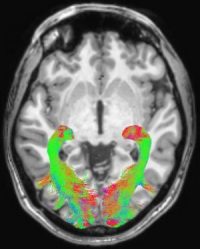- Home
- Editorial
- News
- Practice Guidelines
- Anesthesiology Guidelines
- Cancer Guidelines
- Cardiac Sciences Guidelines
- Critical Care Guidelines
- Dentistry Guidelines
- Dermatology Guidelines
- Diabetes and Endo Guidelines
- Diagnostics Guidelines
- ENT Guidelines
- Featured Practice Guidelines
- Gastroenterology Guidelines
- Geriatrics Guidelines
- Medicine Guidelines
- Nephrology Guidelines
- Neurosciences Guidelines
- Obs and Gynae Guidelines
- Ophthalmology Guidelines
- Orthopaedics Guidelines
- Paediatrics Guidelines
- Psychiatry Guidelines
- Pulmonology Guidelines
- Radiology Guidelines
- Surgery Guidelines
- Urology Guidelines
Researchers identify visual system changes that may signal Parkinson's disease

OAK BROOK, Ill. - Changes in the visual systems of newly diagnosed Parkinson's disease patients may provide important biomarkers for the early detection and monitoring of the disease, according to a new study published online in the journal Radiology.
"Just as the eye is a window into the body, the visual system is a window into brain disorders," said lead researcher Alessandro Arrigo, M.D., a resident in ophthalmology at the University Vita-Salute San Raffaele of Milan, Italy.
Parkinson's disease is a neurodegenerative condition caused by neuronal loss in several brain structures. Parkinson's disease is characterized by tremors, rigidity or stiffness throughout the body, and impaired balance and coordination.
"Although Parkinson's disease is primarily considered a motor disorder, several studies have shown non-motor symptoms are common across all stages of the disease," Dr. Arrigo said. "However, these symptoms are often undiagnosed because patients are unaware of the link to the disease and, as a result, they may be under-treated."
Non-motor symptoms experienced by patients with Parkinson's disease include visual alterations such as an inability to perceive colors, a change in visual acuity, and a decrease in blinking which can lead to dry eye.
"These non-motor Parkinson's symptoms may precede the appearance of motor signs by more than a decade," Dr. Arrigo said.
The study of 20 newly diagnosed and not yet treated patients (11 men, 9 women) with Parkinson's disease and 20 age- and gender-matched healthy controls involved a multi-disciplinary team of researchers in ophthalmology, neurology and neuroradiology of the University of Messina, Italy. MRI was performed on both the healthy controls and the patients, who underwent imaging within four weeks of their diagnosis. Researchers used an MRI technique called diffusion weighted imaging to assess white matter changes and voxel-based morphometry (VBM) to investigate concentration changes of brain's gray and white matter. All study participants also had ophthalmologic examinations.
The researchers found significant abnormalities within the visual system brain structures of Parkinson's disease patients, including alterations of optic radiations, a reduction of white matter concentration and a reduction of optic chiasm volume. The optic chiasm is the part of the brain where the left and right optic nerves intersect.
"The study in depth of visual symptoms may provide sensitive markers of Parkinson's disease," Dr. Arrigo said. "Visual processing metrics may prove helpful in differentiating Parkinsonism disorders, following disease progression, and monitoring patient response to drug treatment."
Dr. Arrigo added that future studies are needed to better understand the timing of degeneration along visual pathways, as well as the specific changes.
"We're excited by our findings," he said. "However, this is just a starting point."

Disclaimer: This site is primarily intended for healthcare professionals. Any content/information on this website does not replace the advice of medical and/or health professionals and should not be construed as medical/diagnostic advice/endorsement or prescription. Use of this site is subject to our terms of use, privacy policy, advertisement policy. © 2020 Minerva Medical Treatment Pvt Ltd